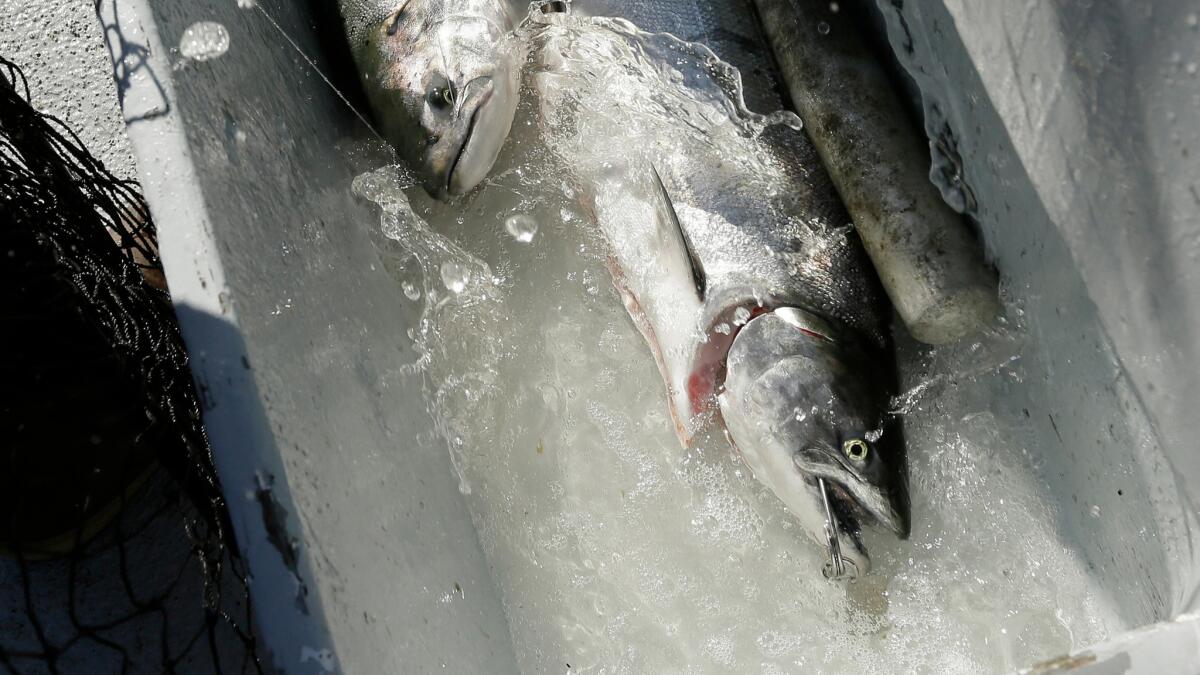Editorial: Why are we sending precious water downstream for fish in the middle of a drought? Here’s why.

California is not merely a political jurisdiction drawn on a map. Even without the human artifice of state lines, it exists as a physically and ecologically distinct place, characterized and enriched by iconic species that live only here — the California condor, the giant sequoia, the golden trout, the coast live oak and hundreds of others. It has entire ecosystems found nowhere else, such as the coastal redwood forests and the chaparral. It is also the beginning and ending point for species that make one of the planet’s most amazing migratory journeys: the salmon.
Those of us who know this fish mostly from the grocery store or on the plate (or on a bagel) may think of salmon as creatures of Alaska, the Columbia River, or perhaps Scotland. But some fish biologists believe that the Chinook salmon, and perhaps all Pacific salmon species, can ultimately be traced to the southern Sierras and the pools of snowmelt that turn into the Stanislaus, Merced, Tuolomne and San Joaquin Rivers, all salmon highways that link the mountains to the open ocean.
Soil scientists were once puzzled by how marine nutrients so greatly enriched coastal and mountain forests, so many miles from the Pacific, but they finally found their answer in the salmon that returned to their spawning pools and were eaten and distributed by predators — formerly grizzly bears, now extinct here, but even today by black bears, raccoons and other animals. The state’s rich farmland is a result in part of salmon, and some studies have attributed the particular attributes of Napa Valley and Russian River vineyards to centuries of enrichment by salmon carcasses. Much of what makes California special, from redwoods to Zinfandel to the carrion-eating condor, is knitted together by, and may be possible only because of, salmon.
Much of what makes California special, from redwoods to Zinfandel to the carrion-eating condor, may be possible only because of salmon.
Millennia of evolution have created varieties of salmon so finely attuned to seasonal rhythms that there are identifiable biological distinctions between fish that hatch and begin their journeys at different times of the year. Winter-run salmon, for example, need water temperatures and flows that are different from their spring-run cousins, even of the same species.
Diversions of water for urban and agricultural use have combined with drought to leave water levels so low, and consequently at temperatures so high, that last year’s winter run was virtually wiped out. That means a serious hit to a $1-billion fishing industry and, even more important in the long term, a severing of one more link in an ecological chain that keeps the state healthy and productive. The continuing drought could easily mean successive extinctions of salmon runs and then — that’s it. They’re gone.
In this sixth year of drought, the agriculture industry and its supporters have pushed hard for diverting every scarce drop of water flowing down streams and rivers to orchards and field crops instead of, as they often describe it, allowing good water to be flushed downriver, through the Delta, into the San Francisco Bay and out to sea.
But like the water that sustains the Everglades, the water that is allowed to move through the Sacramento-San Joaquin River Delta and into the Pacific is not wasted. It is the lifeblood of an ecosystem whose health is essential not just to a particular run of salmon but to agriculture, to the fishing industry, to the economy and to the special qualities that make California what it is.
The state south of the Delta remains in drought, but Northern California had a wet winter that refilled reservoirs and gave rice farmers and other growers hope that water supply cutbacks might be eased. The State Water Resources Control Board last week began considering a proposal to use much of that water not to support crops but to sustain the flows that in turn sustain the fish. It’s a worthy plan. Just as Los Angeles residents were prepared to take on a little more hardship and a little less water in order to preserve and sustain distant Mono Lake, to partially restore the Owens Valley and to repair and reverse other environmental damage — and just as they must adapt to even less water in coming years — growers too should be prepared to scale back their wants and needs to ensure that the state and its iconic species survive.
For a complete list of The Times’ endorsements for the Nov. 8 ballot, go to latimes.com/endorsements.
Follow the Opinion section on Twitter @latimesopinion and Facebook
MORE FROM OPINION
In the Nixon-Humphrey election, I refused to vote for the ‘lesser of two evils.’ That was a mistake
Ensuring access to safe drinking water ought to come before a push for soda taxes
More to Read
A cure for the common opinion
Get thought-provoking perspectives with our weekly newsletter.
You may occasionally receive promotional content from the Los Angeles Times.










